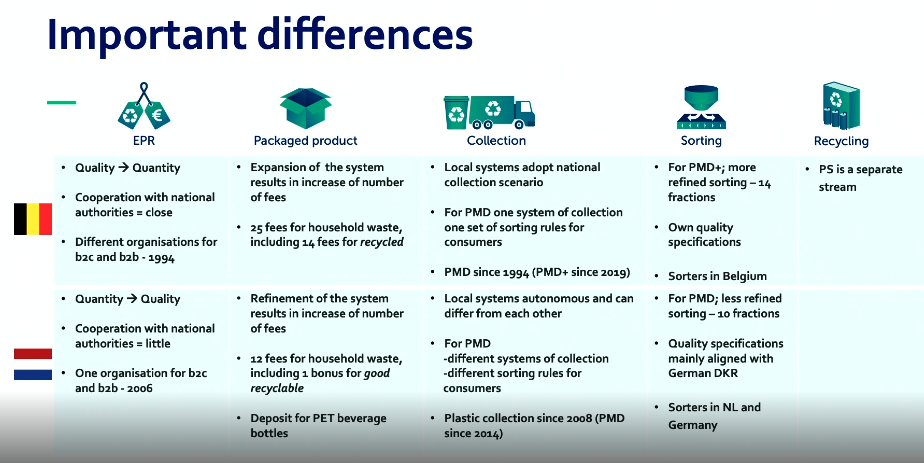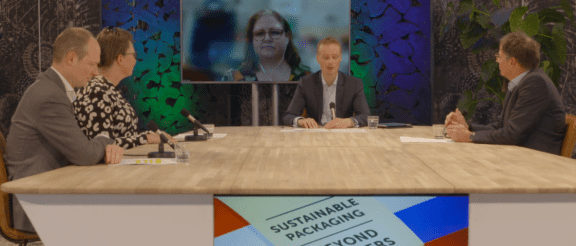KIDV continues as Verpact
November 6, 2025
The Netherlands and Belgium have their own systems for collecting and processing household packaging waste. At first sight, there seem to be major differences between the two countries. But if you take a closer look, you will discover many similarities. The systems are even starting to look more and more alike. There are therefore plenty of opportunities for cooperation and harmonisation. The Netherlands Institute for Sustainable Packaging (KIDV) and Fost Plus are going to work on this, so they announced on 2 December during their joint webcast 'Sustainable packaging beyond borders'.
In 2020, KIDV and Fost Plus were at the forefront of PackForward, the European movement for sustainable packaging. At the launch, it was still mainly about intentions and ideas to get international cooperation going. "The time of getting to know each other and exploring is over; we are moving into the implementation phase. We are already working together to link up the Belgian design for recycling guidelines and the KIDV Recyclecheck. Now we want to continue the cooperation on other themes and on a larger international scale", say directors Chris Bruijnes (KIDV) and Steven Boussemaere (Fost Plus). The aim is to achieve greater harmonisation in the international packaging chain.
Fost Plus is the Belgian organisation that implements producer responsibility (EPR) for household packaging waste. Our southern neighbours have a separate organisation for industrial waste, Valipac. In the Netherlands, one organisation fulfils the EPR for both streams: the Afvalfonds Verpakkingen, which also includes the KIDV, Nedvang and Nederland Schoon. The cooperation between KIDV and Fost Plus gave rise to the idea to take a closer look at the systems in both countries and see where the differences and similarities lie. In terms of recycling figures, the Netherlands and Belgium are among the leaders in Europe. What can they learn from each other? How can they help international companies take steps to make their packaging more sustainable? There was a great deal of curiosity about this, as evidenced by the high number of participants: no fewer than 377 joined in online.
"In 2019, Fost Plus extended the uniform door-to-door collection of PMD via the blue bag to all plastic packaging. As a result, the quantity of collected PMD per inhabitant per year increased by fifty percent, from 15 to 23 kg", said director Mik Van Gaever in his presentation on how Fost Plus works in Belgium. Furthermore, the sorting and recycling capacity was renewed and expanded. The PMD stream is sorted in a fine mesh, to no fewer than fourteen fractions at the moment and this may become fifteen or sixteen. Belgium also scores high recycling percentages for the other material flows, above the European objectives. With design-for-recycling guidelines, Fost Plus gives companies who want to make their packaging more sustainable and more recyclable a handhold. By following the do's and don'ts, they can be sure that their packaging will enter the sorting and recycling chain without any problems. For recyclable packaging, companies pay a lower Green Dot fee, as the waste management contribution is called in Belgium.
Click here for the presentation of Mik Van Gaever/Fost Plus.
Bianca Lambrechts, director of Nedvang BV, listed the collection and sorting in the Netherlands: in many municipalities, citizens separate their waste at home, other municipalities opt for subsequent separation. Municipalities conduct their own collection policy to motivate citizens to produce as little residual waste as possible, also through financial incentives. Plastic packaging from the PMD stream is sorted into mono and mixed streams, or it ends up in residual waste. In a video message, Hester Klein Lankhorst, director of Afvalfonds Verpakkingen, said: 'We are on the right track, but there are still many challenges: the collection rates and the quality of the separated streams must improve. Improvements are needed both upstream, in the design of packaging, and downstream, in sorting and recycling. Innovation and cooperation throughout the chain are essential if we are to achieve the ever higher recycling targets of the future."
Click here for the presentation of Bianca Lambrechts/Nedvang (Afvalfonds Verpakkingen).
As the third speaker, packaging expert Karen van de Stadt from KIDV presented the results of a comparison of the Dutch and Belgian situations. "We have too many results to summarise and analyse in ten minutes. We are working on the same objectives, but the way in which we want to achieve them differs: there are differences in the organisation and implementation, with different collection and processing systems, which affects cooperation in the chain and communication to consumers." Van de Stadt focused her presentation on the main differences and similarities, because there are some, and their implications for companies operating in both the Dutch and Belgian markets.
An example of the same goal, but a different route, is for companies to qualify for lower rates. The Dutch Packaging Waste Fund (Afvalfonds Verpakkingen) has a modulated fee for rigid plastic packaging. If they are well recyclable according to the KIDV Recyclecheck, companies receive a discount on the so-called waste management contribution. In Belgium, the green dot fees are calculated on the basis of their cost deficit, so plastic packaging with a positive recycling value attracts a lower contribution. Another example: the larger Belgian companies draw up a prevention plan for packaging waste, according to an agreement with the Interregional Packaging Committee. The Netherlands has sector innovation plans for sustainable packaging, drawn up by sectors and their members, with objectives and measures to achieve more sustainable packaging. Van de Stadt: "The Belgian approach is more individual and binding, the Dutch approach is more collective and less binding." On innovations, in general: "The Belgian way is gradual; processes are improved step by step. The Netherlands innovates more disruptively."

The sheets in Karen van de Stadt's presentation provide a more detailed overview of differences and similarities. At the end, she concludes that the differences appear large at first glance, but that the systems in the Netherlands and Belgium are growing closer and becoming more similar. "And there are enough similarities to offer opportunities for more cooperation and harmonisation, such as in the alignment of design guidelines."
Click here for the presentation of Karen van de Stadt/KIDV.
The themes from the various presentations returned in a panel discussion with An Vossen (Plarebel), Marion Beugelsdijk (Albert Heijn), Steven Boussemaere (Fost Plus) and Chris Bruijnes (KIDV), chaired by Mike Jefferson (Verde Consulting). Not only at the table, but also in the chat, lively discussions took place. It became clear that a comparison of systems between different countries provides many valuable insights. Beugelsdijk: "For companies, it is important to have a longer-term perspective. What will we be facing in 2030?
Comparisons with other European countries were also asked for straight away. When setting up the method, it was taken into account that it could also be used for comparisons with other countries. This is included in the PackForward programme. Bruijnes: "Belgium and the Netherlands can in any case work together to achieve more uniformity in design for recycling and the instruments we use for that. We can soon extend this to other countries in Europe. And for us, this is an initial step towards working on new business cases in the chain, so that producers and sorters/recyclers can jointly arrive at the right innovations. In doing so, we must prevent one from being the winner and the other the loser."
Do you have any questions about this webcast? Please let us know via question.kidv.nl.
